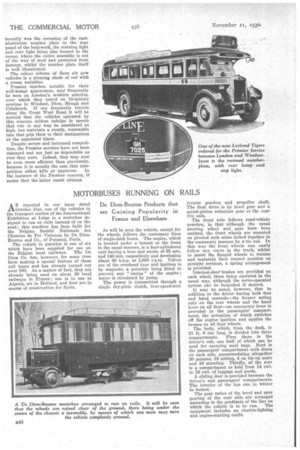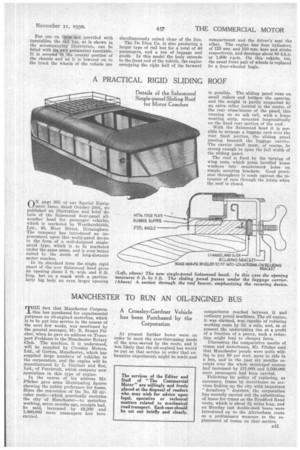MOTORBUSES RUNNING ON RAILS
Page 90

Page 91

If you've noticed an error in this article please click here to report it so we can fix it.
De Dion-Bouton Products that are Gaining Popularity in France and Elsewhere As reported in our issue dated October 21st, one of the vehicles in the transport section of the International Exhibition at Liege is a motorbus designed to run on rails instead of on the road ; this machine has been built for the Belgian Societe Nationale des Chemins de Per Vicinaux by De DionBouton and Co., of Puteaux, Paris.
The vehicle in question is one of six which have been supplied for use on the Belgian local railways. The De Dion Co. has, however, for some time -been making a special feature of these rail buses and has already turned out over 100. As a matter of fact, they are already being used on about 30 local railways in France; one is in use at Algeria, six in Holland, and four are in course of construction for Syria. . As will be seen the vehicle, except for the wheels, follows the customary lines of single-deck buses. The engine, which is located under a bonnet at the front in the usual manner, is a four-cylindered unit having a bore and stroke of 95 mm. and 140 mm. respectively and developing about 60 b.h.p. at 1,600 r.p.m. Valves are of the overhead type and ignition is by magneto, a governor being fitted to prevent any " racing " of the engine ; water is circulated by pump.
The power is transmitted through a single dry-plate clutch, four-speed-and
reverse gearbox and propeller shaft. The final drive is by bevel gear and a spiral-pinion reduction gear to the rear live axle.
The front axle follows road-vehicle practice, in that although the usual steering wheel and gear have been omitted, the front wheels are mounted on pivoted stub axles linked together in the customary manner by tr. tie rod. In this way the front wheels can easily follow any curve in the track, whilst to assist the flanged wheels to resume and maintain their correct position on straight sections, a spring arrangement is provided.
Internal-shoe^ brakes are provided on each wheel, these being operated in the usual way, although the servo-operated system can be furnished if desired.
It may be noted, however, that in addition to the driver having both foot and hand controls—the former acting only on the rear wheels and the hand lever on all four—an emergency lever is Provided in the passengers' compartment, the actuation of which switches off the engine ignition and applies the brakes on all four wheels.
The body, which, from the dash, is 21 ft. 6 ins, long, is divided into three compartments. First there is the driver's cab, one half of which can be used for carrying mail bags. Next is the passengers' compartment with doors on each side, accommodating altogether 30 persons, 16 sitting, 4 on tip-up seats and 10 standing. Thirdly, at the rear is a compartment to hold from 14 cwt. to 16 cwt. of luggage and goods.
A sliding door is provided between the driver's and passengers' compartments. The interior of the bus can in winter be heated.
The gear ratios of the bevel and spur gearing of the rear akin are arranged according to the gradients of the line on which the vehicle is to be run. The equipment includes an electric-lighting and engine-starting outfit. For use on Lillear sot provided with turntables, the rail bus, as is shown in the accompanying illustration, can be fitted with its own permanent turntable. It is secured to the central portion of the chassis and as it is lowered on to the track the wheels of the vehicle are simultaneously raised clear of the line.
The De Dion Co. is also producing a larger type of rail bus for a total of 40 passengers, and a ton of luggage and goods. In this model the body extends to the front end of the vehicle, the engine occupying the right half of the forward compartment and the driver's seat the other. The engine has four 'cylinders, of 125 mm. and 150 mm. bore and stroke respectively, and develops about 80 b.h.p. at 1,600 r.p.m. On this vehicle, too, the usual front pair of wheels is replaced by a four-wheeled bogie.




















































































































































